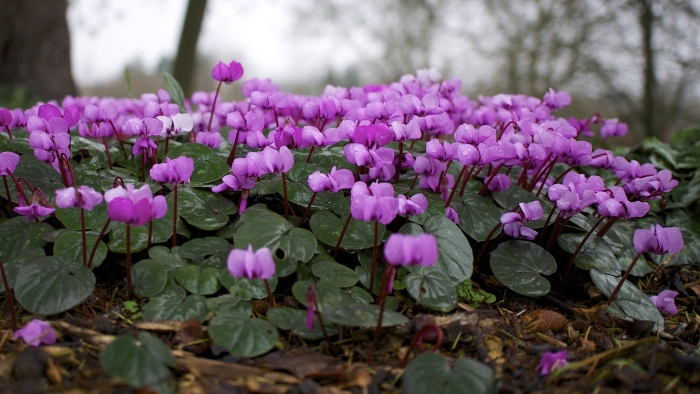Eastern Sowbread
(Cyclamen coum)
Eastern Sowbread (Cyclamen coum)
/
/

Ian Kirk from Broadstone, Dorset, UK
CC BY 2.0
Image By:
Ian Kirk from Broadstone, Dorset, UK
Recorded By:
Copyright:
CC BY 2.0
Copyright Notice:
Photo by: Ian Kirk from Broadstone, Dorset, UK | License Type: CC BY 2.0 | License URL: https://creativecommons.org/licenses/by/2.0 | Uploader: File Upload Bot (Magnus Manske) | Publisher: Wikimedia Commons | Title: Cyclamen_(8457919409).jpg | Notes: |



































Estimated Native Range
Summary
Cyclamen coum, commonly known as Eastern Sowbread, is a deciduous perennial herb native to woodland areas, alpine meadows, and scrubby slopes in the Eastern Mediterranean and the Black Sea region. This species typically grows to a height of 5–8 cm (2–3 in) and features rounded, heart-shaped leaves that are often marbled with silver and green patterns. The pink shell-shaped flowers, notable for their darker coloration at the base, bloom in winter and early spring, adding color to the garden when few other plants flower. The flowers are distinctive, with reflexed petals that give them a unique appearance compared to other cyclamen species.
Eastern Sowbread is appreciated for its winter blooms and as a resilient groundcover in rock gardens, woodland settings, and shaded borders. Its ability to thrive in cooler climates, as demonstrated by its survival in areas of New York with temperatures as low as −19 °F (−28 °C), makes it a valuable addition to northern gardens. It requires part shade to maintain its vibrant foliage and flowers, and prefers well-drained soils with moderate moisture. While generally low-maintenance, it can be susceptible to cyclamen mite and vine weevil infestations, and overwatering can lead to tuber rot. Gardeners should be aware that all parts of the plant are toxic if ingested.CC BY-SA 4.0
Eastern Sowbread is appreciated for its winter blooms and as a resilient groundcover in rock gardens, woodland settings, and shaded borders. Its ability to thrive in cooler climates, as demonstrated by its survival in areas of New York with temperatures as low as −19 °F (−28 °C), makes it a valuable addition to northern gardens. It requires part shade to maintain its vibrant foliage and flowers, and prefers well-drained soils with moderate moisture. While generally low-maintenance, it can be susceptible to cyclamen mite and vine weevil infestations, and overwatering can lead to tuber rot. Gardeners should be aware that all parts of the plant are toxic if ingested.CC BY-SA 4.0
Plant Description
- Plant Type: Herb
- Height: 0.3-0.4 feet
- Width: 1.5-2.5 feet
- Growth Rate: Moderate
- Flower Color: Pink, Purple, White
- Flowering Season: Fall, Winter
- Leaf Retention: Deciduous
Growth Requirements
- Sun: Part Shade
- Water: Medium
- Drainage: Fast
Common Uses
Bank Stabilization, Bee Garden, Deer Resistant, Drought Tolerant, Fragrant, Groundcover, Low Maintenance, Potted Plant, Rock Garden, Showy Flowers, Street Planting
Natural Habitat
Woodland areas, alpine meadows, and scrubby slopes in the Eastern Mediterranean and the Black Sea region
Other Names
Common Names: Dvärgcyklamen
Scientific Names: , Cyclamen coum, Cyclamen durostoricum, Cyclamen coum f. pallidum, Cyclamen coum subsp. alpinum, Cyclamen caucasicum, Cyclamen ibericum, Cyclamen apiculatum, Cyclamen brevifrons, Cyclamen calcareum
GBIF Accepted Name: Cyclamen coum Mill.